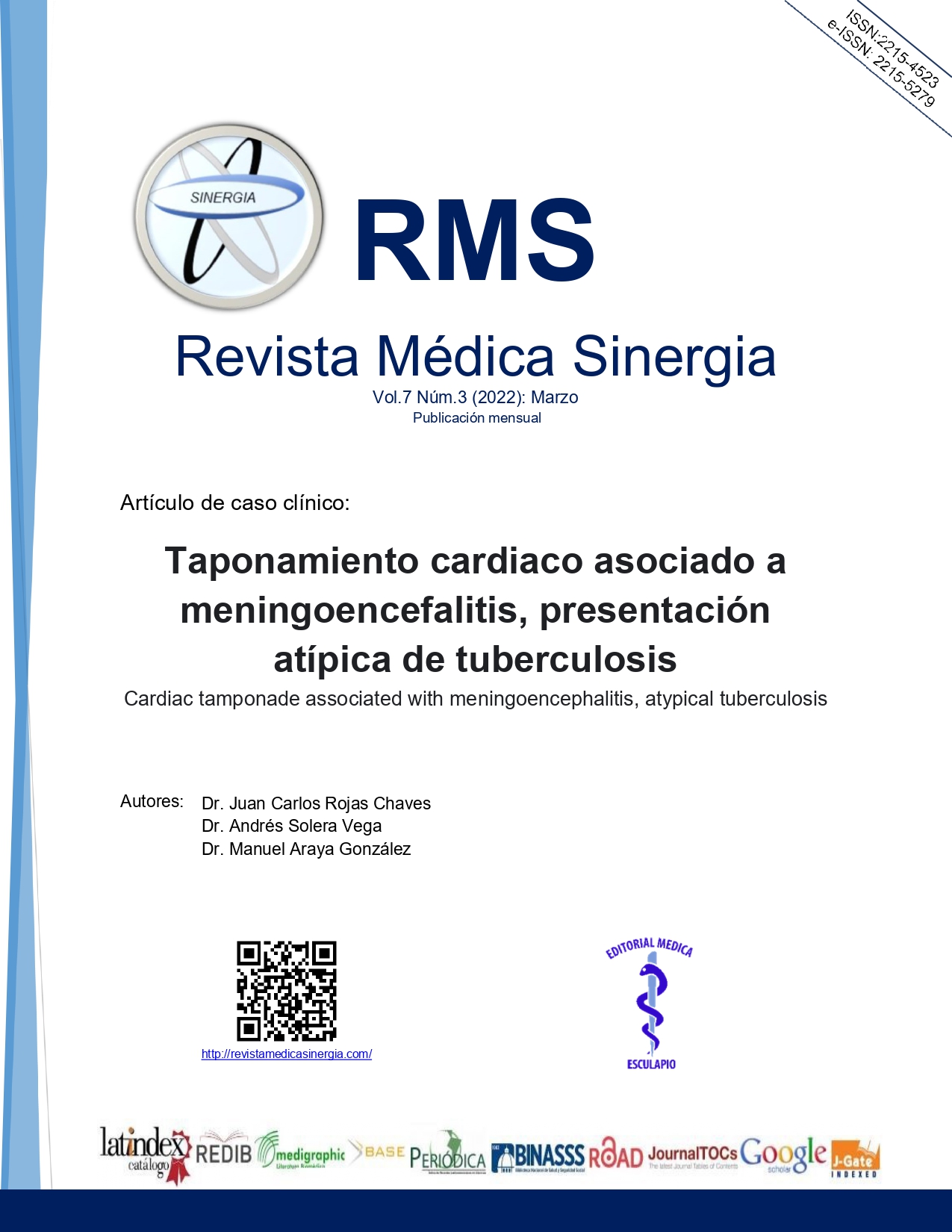Abstract
Tuberculosis remains a disease with a high incidence worldwide even today. Albeit progress has been made in new methods to diagnose it, on many occasions disease identification keeps being a challenge, especially in extrapulmonary cases given the non-specific nature of its symptoms. A high clinical suspicion of disease with a multidisciplinary and systematic approach, become essential tools for early recognition and timely treatment. Despite advances in immunopathogenesis knowledge, unclear areas continue to exist, such as the individual response to bacillus infection and particular susceptibility to serious forms. Treatment paradoxical reactions are an example of these uncertainties. The combination of steroids and antibiotic treatment has been shown to reduce mortality and sequelae, particularly in extrapulmonary forms. Despite appropriate diagnosis and treatment, sometimes the disease advances to an ineluctable death because of the advanced presentation at first approach. The case of a patient with a clinic of pericardial effusion and cardiac tamponade is presented. He subsequently presents data of tuberculosis meningoencephalitis and despite an early diagnosis and appropriate treatment after his hospitalization, evolves to hydrocephalus by requiring surgical shunt and subsequently dies from related complications.
Keywords
References
Lange C, Aaby P, Behr MA, Donald PR, Kaufmann SHE, Netea MG, Mandalakas AM. 100 years of Mycobacterium bovis bacille Calmette-Guérin. Lancet Infect Dis.2022 Jan;22(1):e2-e12. doi: 10.1016/S1473-3099(21)00403-5. Epub 2021 Sep 7. PMID: 34506734.
World Health Organization, Global Tuberculosis Report 2021,https://www.who.int/publications/i/item/9789240037021,ISBN:978924003702.
Mezochow A, Thakur K, Vinnard C. Tuberculous Meningitis in Children and Adults: New Insights for an Ancient Foe. Curr Neurol Neurosci Rep. 2017 Sep 20;17(11):85. doi: 10.1007/s11910-017-0796-0. PMID: 28932979; PMCID: PMC5729589.
Sharma SK, Mohan A. Miliary Tuberculosis. Microbiol Spectr. 2017 Mar;5(2). doi: 10.1128/microbiolspec.TNMI7-0013-2016. PMID: 28281441.
Thuong NTT, Vinh DN, Hai HT, Thu DDA, Nhat LTH, Heemskerk D, Bang ND, Caws M, Mai NTH, Thwaites GE. Pretreatment Cerebrospinal Fluid Bacterial Load Correlates With Inflammatory Response and Predicts Neurological Events During Tuberculous
Meningitis Treatment. J Infect Dis. 2019 Feb 23;219(6):986-995. doi: 10.1093/infdis/jiy588. PMID: 30299487.
Sinner SW. Approach to the diagnosis and management of tuberculous meningitis. Curr Infect Dis Rep. 2010 Jul;12(4):291-8. doi: 10.1007/s11908-010-0106-3. PMID: 21308544.
Raut T, Garg RK, Jain A, Verma R, Singh MK, Malhotra HS, Kohli N, Parihar A. Hydrocephalus in tuberculous meningitis: Incidence, its predictive factors and impact on the prognosis. J Infect. 2013 Apr;66(4):330-7. doi: 10.1016/j.jinf.2012.12.009. Epub 2013 Jan 2. PMID:
Rock RB, Olin M, Baker CA, Molitor TW, Peterson PK. Central nervous system tuberculosis: pathogenesis and clinical aspects. Clin Microbiol Rev. 2008 Apr;21(2):243-61. doi: 10.1128/CMR.00042-07. PMID: 18400795; PMCID: PMC2292571.
Raut T, Garg RK, Jain A, Verma R, Singh MK, Malhotra HS, Kohli N, Parihar A. Hydrocephalus in tuberculous meningitis: Incidence, its predictive factors and impact on the prognosis. J Infect. 2013 Apr;66(4):330-7. doi: 10.1016/j.jinf.2012.12.009. Epub 2013 Jan 2. PMID: 23291048.
Naicker K, Ntsekhe M. Tuberculous pericardial disease: a focused update on diagnosis, therapy and prevention of complications. Cardiovasc Diagn Ther. 2020 Apr;10(2):289-295. doi: 10.21037/cdt.2019.09.20. PMID: 32420111; PMCID: PMC7225424.
Isiguzo G, Du Bruyn E, Howlett P, Ntsekhe M. Diagnosis and Management of Tuberculous Pericarditis: What Is New? Curr Cardiol Rep. 2020 Jan 15;22(1):2. doi: 10.1007/s11886-020-1254-1. PMID: 31940097; PMCID: PMC7222865.
Ramasamy V, Mayosi BM, Sturrock ED, Ntsekhe M. Established and novel pathophysiological mechanisms of pericardial injury and constrictive pericarditis. World J Cardiol. 2018 Sep 26;10(9):87-96. doi: 10.4330/wjc.v10.i9.87. PMID: 30344956; PMCID: PMC6189073.
Nachiappan AC, Rahbar K, Shi X, Guy ES, Mortani Barbosa EJ Jr, Shroff GS, Ocazionez D, Schlesinger AE, Katz SI, Hammer MM. Pulmonary Tuberculosis: Role of Radiology in Diagnosis and Management. Radiographics. Chest Imaging 2017 Jan-Feb;37(1):52-72. doi: 10.1148/rg.2017160032. PMID: 28076011.
Schaller MA, Wicke F, Foerch C, Weidauer S. Central Nervous System Tuberculosis : Etiology, Clinical Manifestations and Neuroradiological Features. Clin Neuroradiol. 2019 Mar;29(1):3-18. doi: 10.1007/s00062-018-0726-9. Epub 2018 Sep 17. PMID: 30225516.
Leonard JM. Central Nervous System Tuberculosis. Microbiol Spectr. 2017 Mar;5(2). doi: 10.1128/microbiolspec.TNMI7-0044-2017. PMID: 28281443.
Garg RK, Malhotra HS, Kumar N. Paradoxical reaction in HIV negative tuberculous meningitis. J Neurol Sci. 2014 May 15;340(1-2):26-36. doi: 10.1016/j.jns.2014.03.025. Epub 2014 Mar 19. PMID: 24680563.
Schutz C, Davis AG, Sossen B, Lai RP, Ntsekhe M, Harley YX, Wilkinson RJ. Corticosteroids as an adjunct to tuberculosis therapy. Expert Rev Respir Med. 2018 Oct;12(10):881-891. doi: 10.1080/17476348.2018.1515628. Epub 2018 Sep 6. PMID: 30138039; PMCID: PMC6293474.
Salas S, Gómez J, Simancas A. Asociación del estado nutricional y factores clínicos con muerte relacionada con tuberculosis en Colombia. Rev Chilena Infectol2021;38(2)161-168.http://dx.doi.org/10.4067/S0716-10182021000200161
Lagos C, Rodriguez J, Peña C, Farga V. Recomendaciones en el tratamiento de la tuberculosis sensible (Según las Guías ATS/CDC/IDSA. 2016).Rev.chil.enferm.respir.2017Mar;33(1):54-61.http://dx.doi.org/10.4067/S0717-73482017000100008.
Rodríguez D, Zapata A, Molina F, Pemuolo G, Burbano J, Correa L. Tuberculosis meníngea: reporte de casos años 2005-2017. Rev. chil. infectol. Jun; 38( 3 ): 410-416. http://dx.doi.org/10.4067/S0716-10182021000300410.

This work is licensed under a Creative Commons Attribution-NonCommercial 4.0 International License.
Copyright (c) 2022 Array


